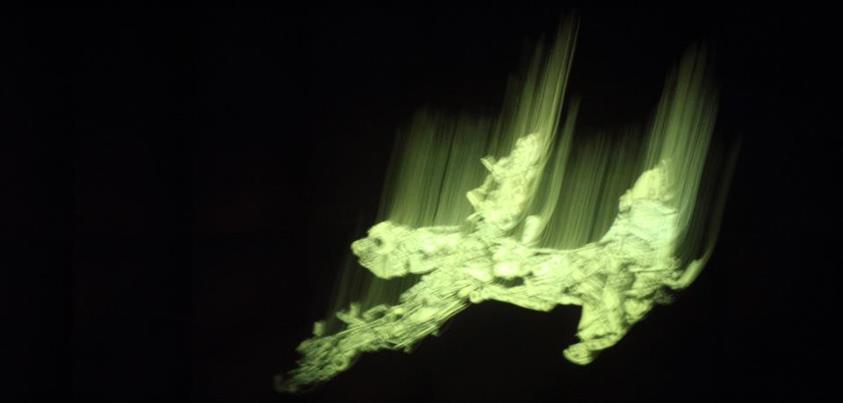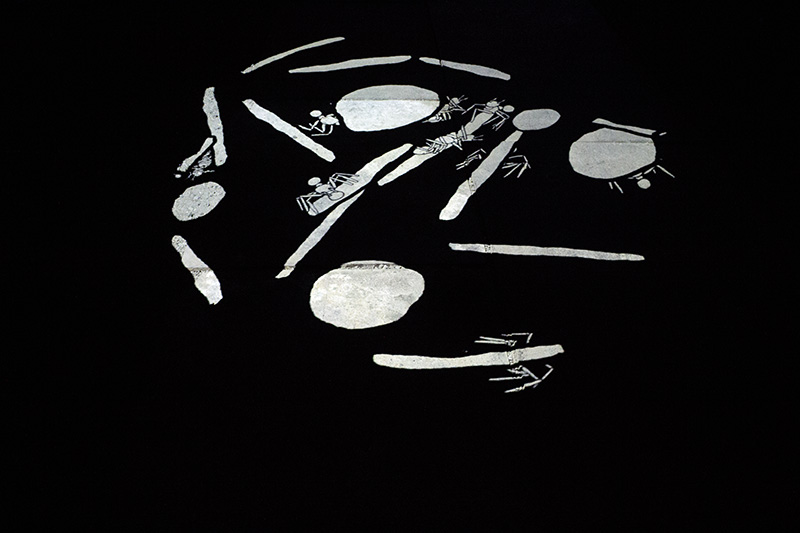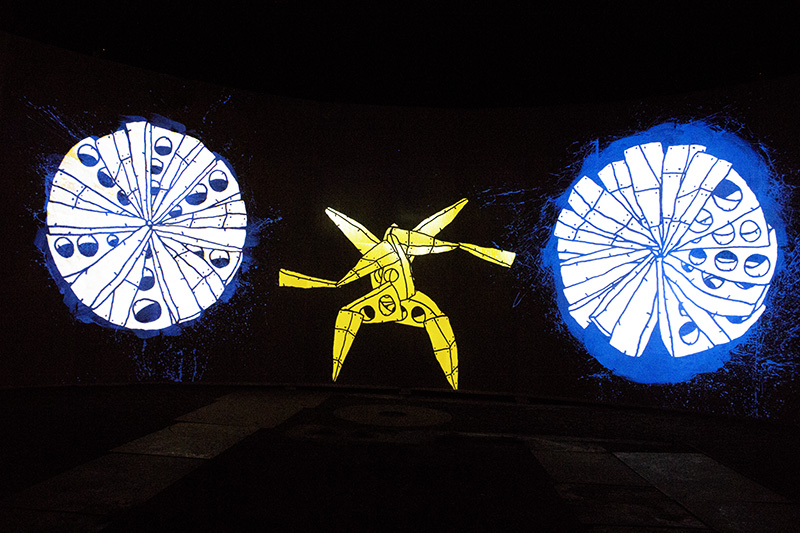 THE ANT NEBULA / 2012-2013
THE ANT NEBULA / 2012-2013
Mikael Ericsson
Large scale videoinstallation with mobile projectors, sculptures, UV-light and sound
15 x 20 x 5 m
Avesta Art, Sweden, 2012 - 2013
THE ANT NEBULA
The visitor is struck by the magic of the universe in Mikael Ericsson’s gigantic celestial body that surprisingly and challengingly has found its place in the expanse of the old rolling mill hall. The universe - an infinity of galaxies, nebulae, planets, stars and black holes – and then the eternal question of what exists beyond infinity.
At a distance Mikael Ericsson’s work gives the impression of being compact matter, formed into a globe in the cosmos. A star with a fixed position in relation to others – or maybe a planet, a wanderer in the firmament. The light that cuts through the shell draws the visitor closer revealing the gateway to a secret room. Inside the covering a curious new world opens up, another cosmos where order in the surroundings is disorder, transient, mystical.
“Everybody has to have an opinion of the world around us. Physical expressions like the room’s size affect us. Fragments of memories, stories, objects and pictures take hold. All impressions – including other people and your own past experiences – are pieces in the jigsaw of our investigation of the world around us and our picture of ourselves. My work at Avesta Art is created in that spirit.”
The work is called Myrnebulosan, The Ant Nebula. The mind boggles at the fervent ant’s micro-colony and the nebulae in the cosmos – clouds of dust where stars are born. In the film that playfully moves over the walls and floor, ants play leading roles. Industriously they work, creating a machine that controls the course of events. The room, which measures 200 square metres, obscures the industrial heritage while the mechanism in it examines technological developments. How often do people think that
they surrender their lives to robots?
Mikael Ericsson’s work is an interplay between different media. The large sculptured room, animations, painting, sound effects, ultraviolet light and in the air a planet with symbols for rubbish and junk. The work is well thought out – and finally improvised on the spot. The artist’s enthusiasm for experiment is contagious, opening the visitor’s sense for unexpected observations and ideas. Apparently trivial pictures are full of seriousness and the room makes people think.
The Ant Nebula is art’s own particle accelerator. Questions about our civilisation – about modern life, the rate of consumption, our attitude to nature and much more – are themes that often occur in Mikael Ericsson’s work.
In Dark Honeymoon in Eskilstuna Art Museum (2009) he juxtaposed frightening pictures of society’s stress and collapse with a meditative feeling that made visitors stop in their tracks and recognise the value of slowing down. Underground Operation in Varberg’s Fort (2010) created a dramatic meeting between memories of medieval disputes, contemporary wars and skyscrapers, and nature’s valiant vegetation. In Notes from the Twin Chamber which was exhibited at Vestfossen Kunstlaboratorium in Norway (2011) there are associations not least with the Twin Towers and 9/11.
At present Mikael Ericsson is working on Harplinge Windmill – an authentic windmill on the coast of Halland which is being converted to a ‘millophone’, a self-playing machine where the wind creates sounds from a mill organ.
Mikael Ericsson was born in 1959 Sweden, studied at the Det Kongelige Danske Kunstakademi in Copenhagen and now lives and works in Halmstad. Since 1994 his artistic work has been placed in his own company TRUMTRUM where he also writes music, makes records and produces works for the theatre and TV. Mikael Ericsson’s work has been exhibited widely including the Moderna Museet in Stockholm last winter.
Text by Karin Perers from the catalogue “Sense and sensibility” Avesta Art, Sweden, 2012
This rotating sculpture was part of the video installation "The Ant Nebula", by Mikael Ericsson, Avesta Art, Sweden. Dimensions: 4x4 meter. Material: UV-paint, foam, wood, engine.
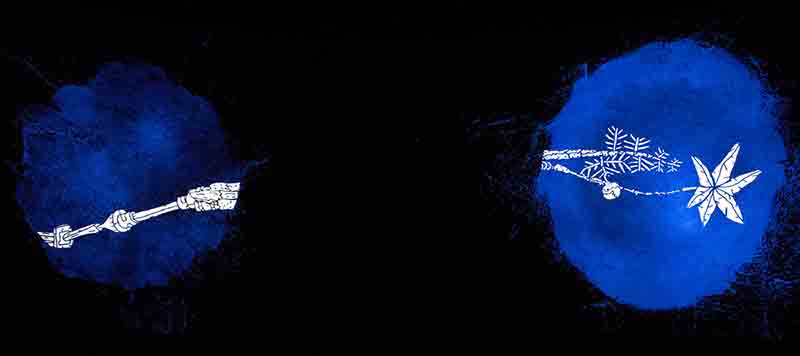
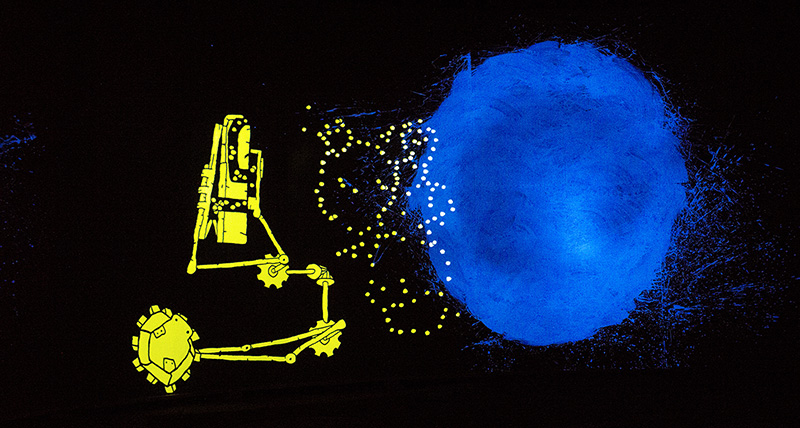
MYRNEBULOSAN
Universums magi drabbar besökaren i och vid Mikael Ericssons enorma himlakropp som överraskande och utmanande har funnit sin plats i den gamla valsverkshallens egen rymd. Universum - En oändlighet av galaxer, nebulosor, planeter, stjärnor och svarta hål – och så den eviga frågan om vad som finns bortom oändligheten.
På håll ger Mikael Ericssons verk intryck av att vara kompakt materia, samlad till ett klot i världsalltet. En stjärna med bestämd position i relation till annat – eller kanske en planet, en vandrare, på himlaranden. Ljuset som skär genom skalet lockar besökaren närmare, visar porten till ett hemligt rum. Innanför höljet öppnar sig en ny egendomlig värld, ett annat kosmos, där ordningen i tillvaron är oordning, tillfälligheter, mystik.
- Varje människa måste förhålla sig till omvärlden. Fysiska uttryck som rummets storlek berör. Fragment av minnen, berättelser, föremål och bilder griper tag. Alla intryck – inklusive andra människor och egna tidigare erfarenheter – är pusselbitar till vår omvärldsspaning och självbild. Mitt verk i Avesta Art är skapat i den andan.
Verket heter Myrnebulosan. Tanken svindlar mellan den nitiska myrans mikrosamhälle och världsrymdens nebulosor – stoftmolnen där stjärnor bildas. I filmiska verk som lekfullt rör sig över väggar och golv har myror framträdande roller. Flitigt arbetar de, skapar en maskin som styr händelseförlopp. Rummet som mäter 200 kvadratmeter skymmer industriarvet medan verket i sig synar teknikutvecklingen. Hur ofta tänker människan på att hon överlämnar sitt liv till robotar?
Mikael Ericssons verk är ett samspel mellan olika uttryck. Det stora skulpturala rummet, animationer, måleri, ljud, ultraviolett ljus och i luftrummet en planet med symboler för skräp och skrot. Verket är noggrant genomtänkt – och slutligen improviserat på plats. Konstnärens experimentlusta är smittande, öppnar besökarens sinne för oväntade iakttagelser och idéer. Till synes lättsamma bilder rymmer stort allvar och rummet inbjuder till reflektion. Myrnebulosan blir en konstens egen partikelaccelerator.
Frågor om vår civilisation – om modernt liv, konsumtionstakt, naturhänsyn och mycket annat – återkommer i Mikael Ericssons konst. I verket ”Dark Honeymoon” i Eskilstuna Konstmuseum (2009) lät han skrämmande bilder av samhällets stress och sammanbrott utmanas av en meditativ känsla, som fick besökare att stanna upp och bejaka långsamhetens värde. ”Underground Operation” i Varbergs fästning (2010) skapade dramatiska möten mellan hågkomster från medeltidens tvister, vår samtids krig och skyskrapor och naturens tappra växtlighet. I ”Notes from the Twin Chamber”, som visades i norska Vestfossen Kunstlaboratorium (2011), gavs associationer inte minst till Twin Towers och elfte september.
Just nu arbetar Mikael Ericsson med Harplinge Windmill – en autentisk väderkvarn vid Hallands kust som omvandlas till en ”kvarnofon”, en självspelande maskin där vinden låter en kvarnorgel ljuda.
Mikael Ericsson är född 1959, utbildad vid Kungliga Konsthögskolan i Danmark. Sedan 1994 organiserar han sitt konstnärliga arbete i det egna företaget TRUMTRUM, där han bla. skapat TV-serierna: Teve für alle, Kalender für alle och Bank für alle. Mikael Ericsson har ställt ut på många håll, bla. Malmö Konstmuseum 2008, Dunkers Kulturhus 2009 och Moderna Museet 2011.
Karin Perers 2012
Online Catalogue 2012
PRESS
I martinugnshallen visas Mikael Ericssons animationer om livets uppkomst, mer svindlande än i Ridley Scotts ”Prometheus”. Dagens Nyheter
Sveriges Television
Sveriges Radio
DT
